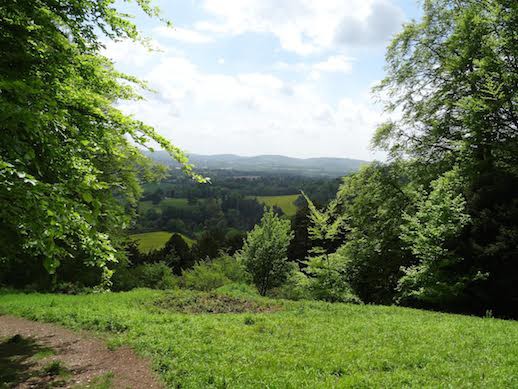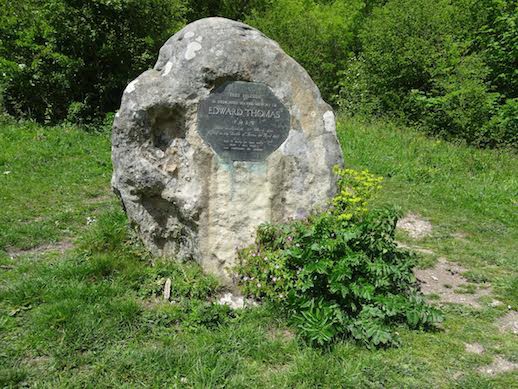Words and pictures by Sue Brooks
I’m on May Hill again, looking South with my long-time walking companion Edward Thomas. This is where we first met, drawn by a shared love of the place and the poem conceived here. “Words”
Out of us all
That make rhymes
Will you choose
Sometimes –
As the winds use
A crack in a wall
Or a drain,
Their joy or their pain
To whistle through –
Choose me,
You English words?
I didn’t know then what is well known now – that for fourteen years he had been enslaved by those same words. Working to impossible deadlines under the yoke of commissions. 60,000 words in four months, four or five books to read and review in one week. The quiet countryside below May Hill and the company of other poets at Dymock in the summer of 1914, transformed his life. He began to write poetry and the following year gave up the hack work and enlisted in the Artist’s Rifles.
May Hill is the landmark for these parts. Its grassy plateau and crown of Scots Pines is protected by the National Trust. It hasn’t changed much since Edward Thomas was there, but the change in me in the last ten years has been profound. Through the prose writing, especially The South Country, The Heart of England, and In Pursuit of Spring I have found a walking companion who has opened my eyes. Rain, roads, paths, maps, songs, names and the naming of things, especially humble things were his delight. “ a meeting of the ways, where a triangular patch of turf is sacred to burdock, ragwort and thistle and – touching the dust of the road – the lowly silverweed”. Towns were places to avoid. I find, for example, if I’m walking along a street, rather than the shop windows or the people, I see the ivy-leaved toadflax at the base of a wall, or the way the roots of a small plane tree are bulging over the pavement in their effort to find water. Taking the dog at lunchtime to the river meadows I rage against the mowing machine which has pointlessly slashed back the hornbeam and chestnut trees on the boundary, and cut the field where the sedge warbler used to sing. There will be no butterflies there this year.
We are looking South because I have planned a small pilgrimage to the chalk downlands he loved. A week later I am in a boggy field outside Steep in Hampshire, a place best known for its private school – Bedales. The Thomas family moved there in 1906 so their eldest child could attend as a day pupil. It lies in the centre of the newly designated South Downs National Park. The park authorities have two purposes:
(a) to conserve and enhance the natural beauty, wildlife and cultural heritage of the area,
(b) to promote opportunities for the understanding and enjoyment of the park’s special qualities by the public,
and (c) a duty to foster the economic and social well-being of the communities living in the National Park.
Wikipedia’s South Downs National Park website shows a group of smiling residents in front of the Waitrose logo, one of them holding up the 2015 Silver Lapwing award for outstanding conservation practice on her farm. Her farm manager had been unable to attend. I recalled the raised eyebrows of friends when I said where I was going. Why Hampshire? And certainly I had reservations, but put them aside for the greater purpose.
The first evening I climbed Ashford Hanger through dark, dense woods with sudden hollows where great trunks lay rotting. Beech and ash mostly, growing very close, and at the top of the ridge, small fields each side of a lane brimming with cow parsley. It was perfectly still and quiet and delightful and I was walking slowly, at ease with the world. After Lythe Farm, another track led steeply down: a holloway so ancient the bank on one side was four feet above my head, lined with the exposed roots of magnificent beeches. Wych elm leaned over the other, small saplings level with my shoulder. More elm than I have seen anywhere else. The pale seed cases lay thickly on dogs mercury and bluebells and on the chalky stones at my feet. I reached the bottom and came out into open fields with cattle grazing and low hills in the distance. A 4 x 4 appeared with a row of headlamps above the windscreen. It passed me and the engine roared under the trees, lost traction and slid back. They tried again – several times – and finally came back to the flat ground and put the landrover to the track like a racehorse. Slashing, splintering, cracking, stones exploding it laboured to the top. Warfare in that quiet place.
In the camping field I talked to the only other resident. Margaret, in her 12 year old VW with a solar panel on the roof and an old-fashioned bicycle padlocked to the rear door. She had been on the road for 33 years in the UK and abroad, mostly in Europe in the winter months working on farms when she needed to. That night I read Edward Thomas’ account of his meetings with the umbrella man. He had a deep fascination and regard for people on the move – their self-sufficiency, their knowledge….. “ every village, every farmhouse he knew and could see with his blue eyes as he remembered them and spoke their names. I never met a man who knew England as he did ”. Margaret was one of these and I was in awe of her. The next day she showed me her Explorer map, much creased and annotated. I had an identical map, brand-new and smelling of carbon. “There isn’t a footpath around here I don’t know” and she moved her finger and named her favourite places.
On the last day I took the walk Margaret had drawn on the map, following Ashford Stream to the edge of the Hanger and out onto the summit of Shoulder of Mutton Hill. A section of the Hanger shorn of trees, as it had been when Edward Thomas walked there, all the wild flowers of calcareous grassland in glorious array, and half-way down, the sarsen stone with his name and dates of birth and death.
THIS HILLSIDE IS DEDICATED TO THE MEMORY OF
EDWARD THOMAS
POET
Born in Lambeth 3rd March 1878
Killed at the Battle of Arras 9th April 1917
Impossible not to feel the pathos and struggle of his short life, and be close to tears, but not for long in that beautiful place with the clear light on woods and fields, and the misty outline of the Downs beyond. Two brimstone butterflies chased each other at the edge of the trees.
Back home, saluting May Hill as I passed, I noticed the triangle of tall grasses and oxeye daisies outside the church at the top of my road had been strimmed. I took a walk around the garden, naming the plants: foxglove, cranesbill, pink campion, purple toadflax, marjoram, field scabious, betony, columbine, honeysuckle, bush vetch, knapweed, oxeye daisies, snapdragon, comfrey, creeping butterfly, alkanet, St John’s wort, willowherb. I put out seed for the birds and the male yellowhammer came. Perhaps the female is sitting on eggs somewhere before the mowing starts. Then the bullfinch couple, the female with her grotesquely diseased feet, so crippled she rests on her belly to feed. I signed an online petition to continue the ban on neonicotinoids and thought about Hampshire. Conservation and enhancement and economic and social well-being were evident, but left me uneasy. It felt like a protected area, an enclave like my garden, when all around it was under attack. Even Hampshire, when I was awake early listening for the dawn chorus, had very few birds – a couple of magpies, a crow, some woodpigeons in the distance. These are the things I see now, the things my walking companion would also see. There would be joy, but more and more acutely, there would be pain.

